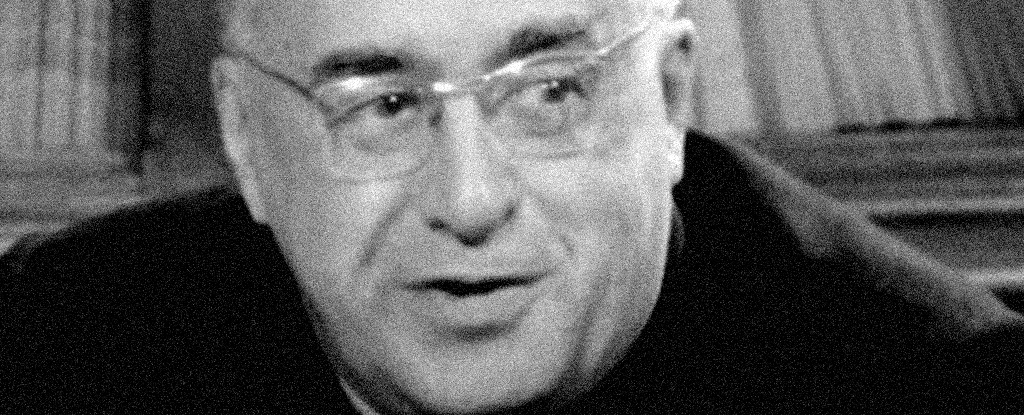Products You May Like
It’s not every day you get to rediscover the words of a world-famous thinker, an influencer of Albert Einstein himself.
A nearly 20-minute video interview with the ‘father of the Big Bang‘ was found in the archives of a public-service broadcaster called Vlaamse Radio- en Televisieomroeporganisatie (VRT), located in the Flemish region of Belgium.
Watching the lost footage, scientists say, feels like “peeking through time”.
The intellectual interview, conducted in French, was originally aired in 1964, and the footage was thought to have gone missing. Now, it’s finally been recovered and is available online for all to see, albeit with Flemish subtitles. For those who don’t speak Flemish or French, an English translation has also been provided in a preprint paper on arXiv.
Georges Lemaître was a Belgian cosmologist and Catholic priest who was the first to figure out the Universe is expanding, even before Edwin Hubble demonstrated the effect with the world’s largest telescope.
Lemaître’s logic ultimately convinced Einstein in the early 1930s to accept that he was wrong and that the Universe could not be static, given the General Theory of Relativity.
According to Lemaître, the Universe was hatched from a primeval ‘cosmic egg’, an atom that had exploded into an ever-expanding firework show of cosmic rays that continues to this day.
Yet not everyone was persuaded by Lemaître’s theory, and much of his interview in 1964 was dedicated to rebutting his challengers.
“A very long time ago,” Lemaître explains in the footage, “before the theory of the expansion of the universe (some 40 years ago), we expected the universe to be static. We expected that nothing would change.”
This is known as the Steady State hypothesis, an idea championed by the English astronomer Fred Hoyle to oppose Lemaître’s ideas.
According to Hoyle, the Universe was constantly creating new matter in an unchanging yet dynamic way, like a “smoothly flowing river”.
If this is true, if matter is continuously being created and sent downriver, there should be a mixture of young and old galaxies spread throughout the Universe.
On the other hand, the Big Bang (a term coined by Hoyle) would mean older galaxies lie further from the blast’s epicenter.
For many years, these two scenarios were hotly debated, and it wasn’t until the 1950s that astronomical observations confirmed the latter situation to be true.
“What will be the first result of this disintegration, as far as we can follow the theory, is, in fact, to have a universe, an expanding space filled by a plasma, by very energetic rays going in all directions,” Lemaître explains in the recently rediscovered interview.
“Something which does not look at all like a homogeneous gas. Then by a process that we can vaguely imagine, unfortunately, we cannot follow that in very many details, gasses had to form locally; gas clouds moving with great speeds… “
Both Hoyle and Lemaître agreed these gas clouds are made almost entirely of hydrogen. But the two scientists disagreed on how these hydrogen gasses came to be.
Hoyle thought they were produced naturally through “a reasonable physical process”, explains Lemaître in the interview. Lemaître thought of the beginning as “a kind of phantom hydrogen which appears with just the right amount of hydrogen to verify an a priori law.”
The cosmic rays shooting through the Universe are essentially fossils of that initial ghostly atom.
“Of all the people who came up with the framework of cosmology that we’re working with now, there’s very few recordings of how they talked about their work,” says physicist Satya Gontcho A Gontcho from the US Department of Energy, a coauthor on the preprint paper.
One of the most riveting parts of the lost interview is when Lemaître is asked how he reconciles his scientific theory with his religion.
“I am not defending the primeval atom for the sake of whatever religious ulterior motive,” he says in the interview.
“It is a point obviously a little delicate,” he adds. “I am a bit afraid to elaborate on it in a few words now.”
The astronomer and priest did not find the Big Bang to be at odds with his religion, nor did he think the science demanded a religious explanation. The topic was clearly not one he was interested in openly discussing.
“Lemaître and others gave us the mathematical framework that forms the basis of our current efforts to understand our universe,” says Gontcho.
“Cosmology is trying to understand what happened in the universe’s past – and for most of us who do observations, that means measuring, very precisely, the rate of acceleration of the universe at different moments in time. And if you understand how the universe has expanded at different moments in time, then you’re able to narrow down what dark energy could be.”
The translated interview is available as a preprint on arXiv.
